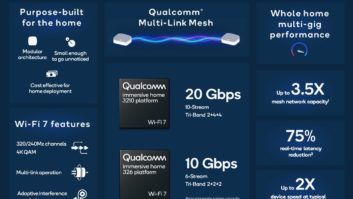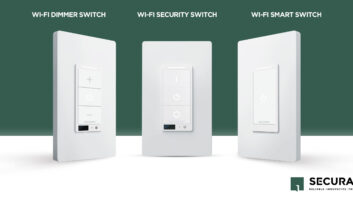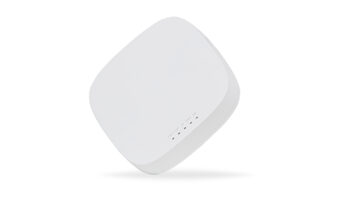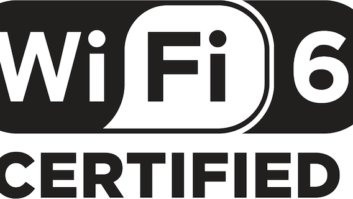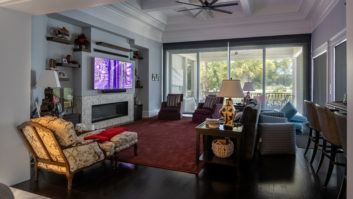As an integrator, I find apartment buildings and condo complexes to be a target-rich environment for business. Why? Building owners and managers are finding themselves under increasing pressure to provide many basic technologies, such as internet access, video security, and even IoT applications, to remain competitive in the rental/sale market.
Installations like these are usually sufficient in size to command a healthy fee. Plus, there are often the opportunities for recurring management fees, as well as ongoing projects.
A curb shot of the Empire Palms complex. Photos by Chris Jensen (www.chrisjensen.com)
One of the access points mounted on an outside courtyard wall next to an apartment door
Tim Phillips in the equipment closet holding one access point with the router also in view.
An aerial view Empire Palms
Interior Hallway Access Point
Tim Phillips Installing the Second Access Point.
Photos by Chris Jensen
A gentleman enjoys consistent access to Wi-Fi in the Empire Palms courtyard.
Tim Phillips Installing Access Point
Laundry Room Access Point
A great example of this is the Empire Palms, a five-building complex housing 58 apartment units, in Ventura, CA. It was built in 1970, so Wi-Fi, obviously, was never even the glimmer of a thought. I’d done some work for the owner a few years earlier, and he contacted me about installing Wi-Fi throughout the complex. He felt it would increase both the marketability of the complex and the value of each apartment.
This not being my first rodeo, nor it being my first project at Empire Palms, I had a pretty good idea that deploying a cloud-managed network would be the best solution.
Cloud-managed Wi-Fi is becoming a standard in my toolkit. Because they require no on-site servers or controllers, these networks have much lower up-front hardware and software costs. Plus, by eliminating those components, you also remove the potential for system-wide failure due to server hardware or software problems. This not only reduces service issues, but it makes for happier tenants, as well.
I also knew that it would reduce my expenses. My business model is to provide a turnkey solution by installing the network and providing ongoing system management. A cloud-managed system allows us to monitor and manage it remotely from our offices, reducing the need to have someone roll to the site without knowing what the issue might be.
After walking the site, we developed a very straightforward plan: Supply each building with a 100 Mbps internet feed, then install a router and a network of access points throughout each building. We’d then set up a proprietary login system for privacy, with each tenant having his/her own username and password.
Looking at those requirements, I recommended deploying an Open Mesh-based system. Open Mesh makes cloud managed access points that I ‘ve found to be cost-efficient and very reliable. But what I’ve found to be their “secret sauce” is their cloud management platform, CloudTrax. It’s the most intuitive and robust management platform I’ve found.
Through CloudTrax, we’re able to monitor and manage, and when necessary adjust each access point on the network. In fact, we’re able to manage every network we’ve installed for every customer through our CloudTrax dashboard. We’re able to diagnose any potential problems, make adjustments to optimize performance of each access point, and make any firmware upgrades at the touch of a button—or schedule them for a convenient time. And, a big bonus in using CloudTrax is that Open Mesh charges no additional license fee to use it. That’s a cost savings that our customers and we appreciate.
CloudTrax also simplifies and speeds up the entire installation and configuration process. But more on that in a minute…
Pre-determining the number of access points you’ll need or their location based solely on square footage is nearly impossible. You may be able to approximate, but every building has its own physical variables that affect the signal distribution and range.
Also, crosstalk is always an ongoing challenge. Fortunately, Open Mesh understands this very well. That’s why their customer support team suggests using more access points at lower signal strength settings rather than fewer APs at higher settings. In fact, they recently recommended throttling down my APs at Empire to improve their performance. Not only did it work, but we were also able to do it from our CloudTrax dashboard without going on-site.
While we’d be able to set up a proprietary login system through CloudTrax, we knew that we’d also need to use content-filtering routers to block the illegal downloading of copywrited content, such as movies and music.
As most integrators know, the liability for illegal downloads falls on the Wi-Fi network owner, which in this case would be the building owner. So to prevent tenants from illegally downloading content, we would want enterprise-grade routers with content filtering. When possible, I prefer to use single-branded system of components for ease of compatibility. But since Open Mesh doesn’t yet offer a router, I recommended Cisco’s Meraki routers, and they’ve worked well.
In total, we installed five Meraki routers (one in each building) and a total of 16 Open Mesh A60 access points. The entire installation took four days, most of which was running the cables, and through CloudTrax we were able to pre-configure the access points in about 10 minutes.
There are certain limitations that building owners and integrators should know before making the decision to install a building/complex-wide Wi-Fi network. First, because each resident has a secure tunnel to the internet and can’t access other devices, printers cannot be used in Wi-Fi mode; they must be connected to a computer with a printer cable.
Also, our system needs users to login with a username and password to use it via a web page portal. That means devices like an Xbox (Roku, Apple TV, etc.) that do not typically have web browsers, meant users cannot log the device onto the Wi-Fi by themselves. Fortunately, we were able to get around that by whitelisting the MAC address of the device. This allows the device to bypass the user authentication system and get online.
As with any new/evolving technology, issues like these arise, but they are being addressed. What doesn’t change is the opportunity for integrators to deliver high-quality, building-wide internet to apartment building owners who want to add to their property value in an increasingly technologically competitive market.










